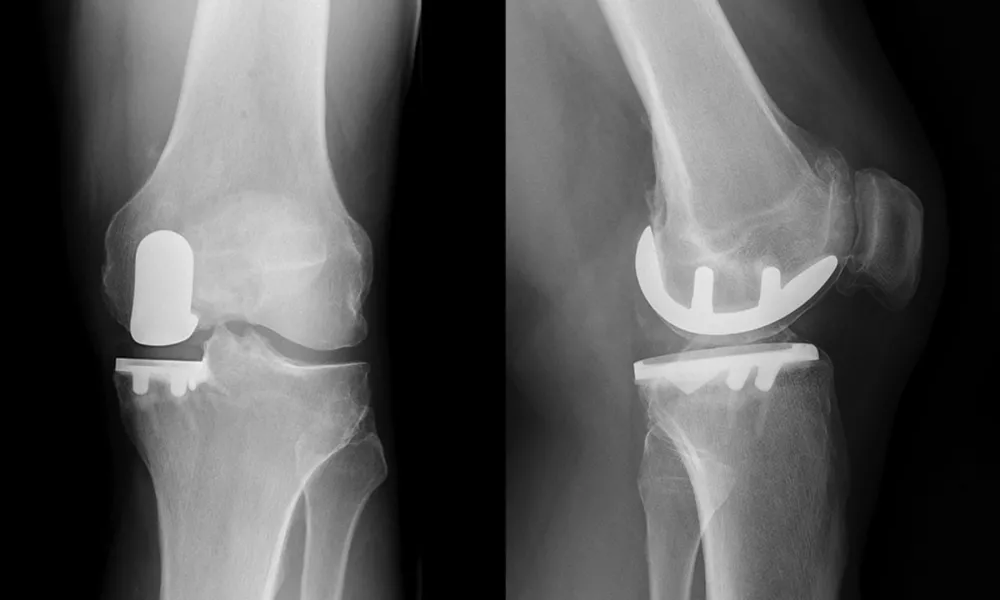Partial Knee Replacement
Partial knee replacement, also known as unicompartmental knee replacement, is a surgical procedure that involves replacing only one of the three compartments of the knee joint affected by arthritis or damage. The knee joint has three compartments: the medial compartment (inside of the knee), the lateral compartment (outside of the knee), and the patellofemoral compartment (front of the knee). If arthritis or damage is limited to one of these compartments, a partial knee replacement may be considered as an alternative to total knee replacement, which involves replacing all three compartments.
Smaller Incision: Compared to total knee replacement, partial knee replacement involves a smaller incision, resulting in potentially less tissue trauma and a quicker recovery time.

Symptoms
Pain: Before surgery, the patient may have experienced chronic knee pain due to conditions such as osteoarthritis or other degenerative knee diseases. After the partial knee replacement, there will likely be some post-operative pain and discomfort. However, over time, as the knee heals, the pain from the underlying condition should significantly improve.
Swelling: Swelling in the knee is a common symptom following partial knee replacement surgery. It is a natural response to tissue trauma during the operation. The swelling should gradually subside as the knee heals and the inflammation decreases.
Stiffness: Some degree of stiffness in the knee is normal after partial knee replacement. Physical therapy and regular exercises prescribed by the surgeon or physical therapist can help improve the knee’s range of motion and reduce stiffness.
Bruising: Bruising around the knee area is common after surgery. It should resolve on its own as the healing progresses.
Limited mobility: Initially, there may be limitations in knee movement due to surgical trauma and post-operative precautions. However, with proper rehabilitation and adherence to the prescribed exercises, mobility should gradually improve.
Numbness or tingling: Some patients may experience temporary numbness or tingling around the incision site. This sensation typically diminishes as the healing progresses.
Treatment
Pre-operative evaluation: Before recommending partial knee replacement, your orthopedic surgeon will conduct a thorough evaluation of your knee joint using physical examination, imaging studies (such as X-rays and MRI), and assess your overall health to determine if you are a suitable candidate for the procedure.
Patient selection: Partial knee replacement is appropriate for individuals who have arthritis confined to one compartment of the knee, typically the medial (inner) compartment or lateral (outer) compartment. Patients with healthy ligaments and stable knee alignment are better candidates for this procedure.
Surgical procedure: During the surgery, your surgeon will make a small incision to access the affected compartment of the knee joint. The damaged bone and cartilage are then removed and replaced with artificial components (implants) made of metal and plastic. The implants are designed to replicate the natural shape and function of the knee joint.
Minimally invasive approach: Partial knee replacement can often be performed using a minimally invasive technique, which involves smaller incisions and less disruption of surrounding tissues. This approach can lead to a faster recovery and reduced post-operative pain.
Precautions
Thorough evaluation: Ensure that the decision for partial knee replacement is based on a comprehensive evaluation by an orthopedic surgeon who specializes in knee surgeries. They will determine if you are an appropriate candidate for the procedure and if it’s the best option for your specific knee condition.
Pre-operative preparation: Follow all pre-operative instructions provided by your surgeon, including medication management, fasting guidelines, and any other preparations needed before surgery.
Manage existing health conditions: If you have any pre-existing health conditions, such as diabetes or heart disease, work with your medical team to optimize their management before undergoing surgery.
Stop smoking: If you smoke, try to quit before the surgery. Smoking can impair healing and increase the risk of complications.
Rehabilitation planning: Discuss the post-operative rehabilitation plan with your surgeon. Understand the exercises and physical therapy regimen you will need to follow after the surgery to regain knee strength and mobility.
